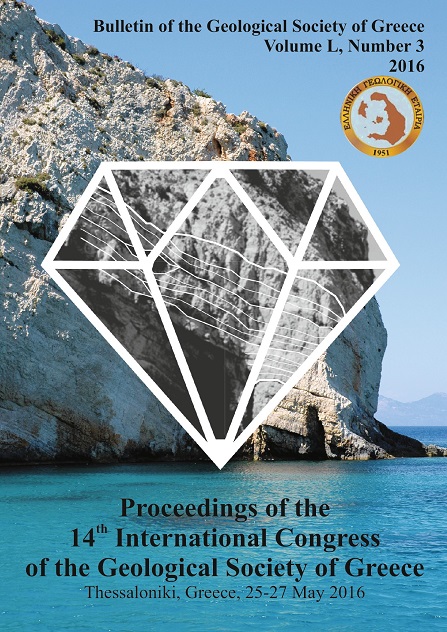ROCK MAGNETIC AND PALAEOMAGNETIC ANALYSES ON LITHIC FRAGMENTS FROM THE ARCHAEOLOGICAL SITE OF AKROTIRI, SANTORINI

Περίληψη
Στην παρούσα εργασία μελετήθηκε η παραμένουσα μαγνήτιση θραυσμάτων λιθικών που βρέθηκαν μέσα στις αποθέσεις ελαφρόπετρας που κάλυψαν τον αρχαιολογικό χώρο του Ακρωτηρίου με σκοπό την εκτίμηση της θερμοκρασίας απόθεσης των πρώτων ηφαιστειακών υλικών που έφτασαν και αποτέθηκαν στον αρχαίο οικισμό. Συνολικά συλλέχτηκαν 50 λιθικά θραύσματα από τέσσερα διαφορετικά σημεία της ανασκαφής. Όλα τα δείγματα απομαγνητίστηκαν με σταδιακή θέρμανση και η ανάλυση των αποτελεσμάτων πραγματοποιήθηκε διαμέσου του διαχωρισμού των κυρίων συνιστωσών μαγνήτισης. Η θερμοκρασία απόθεσης που εκτιμήθηκε αντιπροσωπεύει την θερμοκρασία των λιθικών μετά την αποκατάσταση της θερμικής ισορροπίας μεταξύ αυτών και της θερμότερης ελαφρόπετρας και διαφέρει από λιθικό σε λιθικό. Παρ' όλα αυτά, στο μεγαλύτερο μέρος τους τα λιθικά δείχνουν ότι έχουν αναθερμανθεί σε θερμοκρασίες της τάξεως 240-280oC. Αυτές οι θερμοκρασίες είναι ανάλογες με τις θερμοκρασίες απόθεσης που εκτιμήθηκαν από την μελέτη λιθικών από το ορυχείο του Μεγαλοχωρίου ενώ είναι υψηλότερες από αυτές που εκτιμήθηκαν διαμέσου κεραμικών από την ανασκαφή του Ακρωτηρίου. Τα νέα αποτελέσματα θερμοκρασίων απόθεσης από λιθικά στο εσωτερικό του αρχαίου οικισμού δείχνουν ότι το στρώμα ελαφρόπετρας ήταν ακόμη ζεστό όταν αποτέθηκε μέσα στον αρχαιολογικό χώρο και παρότι ήρθε σε επαφή με τα κτίρια προκαλώντας σε ορισμένες περιπτώσεις την πτώση των οροφών, παρ' όλα αυτά παρέμεινε θερμό με μέση θερμοκρασία περίπου 260 οC.
Λεπτομέρειες άρθρου
- Πώς να δημιουργήσετε Αναφορές
-
Tema, E. (2016). ROCK MAGNETIC AND PALAEOMAGNETIC ANALYSES ON LITHIC FRAGMENTS FROM THE ARCHAEOLOGICAL SITE OF AKROTIRI, SANTORINI. Δελτίο της Ελληνικής Γεωλογικής Εταιρείας, 50(3), 1250–1257. https://doi.org/10.12681/bgsg.11831
- Ενότητα
- Γεωφυσική και Σεισμολογία

Αυτή η εργασία είναι αδειοδοτημένη υπό το CC Αναφορά Δημιουργού – Μη Εμπορική Χρήση 4.0.
Οι συγγραφείς θα πρέπει να είναι σύμφωνοι με τα παρακάτω: Οι συγγραφείς των άρθρων που δημοσιεύονται στο περιοδικό διατηρούν τα δικαιώματα πνευματικής ιδιοκτησίας επί των άρθρων τους, δίνοντας στο περιοδικό το δικαίωμα της πρώτης δημοσίευσης. Άρθρα που δημοσιεύονται στο περιοδικό διατίθενται με άδεια Creative Commons 4.0 Non Commercial και σύμφωνα με την οποία μπορούν να χρησιμοποιούνται ελεύθερα, με αναφορά στο/στη συγγραφέα και στην πρώτη δημοσίευση για μη κερδοσκοπικούς σκοπούς. Οι συγγραφείς μπορούν να: Μοιραστούν — αντιγράψουν και αναδιανέμουν το υλικό με κάθε μέσο και τρόπο, Προσαρμόσουν — αναμείξουν, τροποποιήσουν και δημιουργήσουν πάνω στο υλικό.



